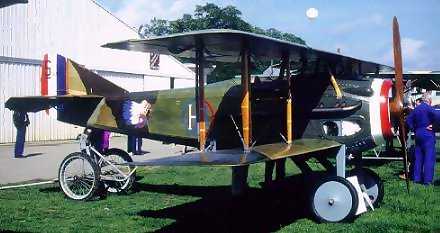SPAD XIII
 SPAD is an acronyn for Société Pour
Apparelis Deperdussin, or, in rough translation, the Deperdussin Aeroplanes Society.
Armand Deperdussin, a silk merchant, was associated with the company as named above from
1910 until the company went bankrupt in 1915 and Deperdussin was arrested for
embezzlement. The initials were also ascribed to Société Provisoire des Aéroplanes
Deperdussin and Société Parisienne des Avions Deperdussin as well as Société
des Productions Armand Deperdussin. The chief technician at the time was Louis
Béchreau and later André Hebermont. Deperdussin was replaced by Louis Blériot, a famous
French aviator. Blériot changed the name to Société Pour Aviation et ses Dérives [Society
for Aviation and its Derivatives] so its initials remained the same.
SPAD is an acronyn for Société Pour
Apparelis Deperdussin, or, in rough translation, the Deperdussin Aeroplanes Society.
Armand Deperdussin, a silk merchant, was associated with the company as named above from
1910 until the company went bankrupt in 1915 and Deperdussin was arrested for
embezzlement. The initials were also ascribed to Société Provisoire des Aéroplanes
Deperdussin and Société Parisienne des Avions Deperdussin as well as Société
des Productions Armand Deperdussin. The chief technician at the time was Louis
Béchreau and later André Hebermont. Deperdussin was replaced by Louis Blériot, a famous
French aviator. Blériot changed the name to Société Pour Aviation et ses Dérives [Society
for Aviation and its Derivatives] so its initials remained the same.
The SPAD line of scouts became renowned in WWI. They first
drew attention from the public when the all-American Lafayette Escadrille (see photo
below) was formed and given SPADs. The S.VII was fast, especially on the level, but
also in a climb or a dive. It was also a very stable gun platform. The SPAD VII first flew
in 1916, over 3,500 were built.
The first SPAD S.VIIs arrived on the Western Front in
September 1916 and were well received by the French escadrilles de chasse, whose
Nieuport 17s had been outclassed by the German Albatros D.I and D.II scouts. By 1917 no
fewer than eight French factories were building SPADS faster than any other aeroplane in
the world. The air arms of Belgium, Britain, Italy, Russia and the United States wanted
them. Five thousand six hundred S.VIIs were built in France alone, with other
manufacturers under license abroad.
As 1917 rolled around, the combat superiority of the SPAD
S.VII dwindled as the new Fokker Dr.1 triplane and
Albatros D.R. came into service. At the suggestion of Lieutenant Georges Guynemer, an ace of Les Cigognes SPA3 squadron, a
special S.XII was built with a 37mm Hotchkiss cannon mounted between the cylinder banks of
the Hispano-Suiza engine. They called it moteur-canon. The gun fired through the
hollow crankshaft and propeller hub which were raised in line with the cannon via a geared
drive. Guynemer shot down four enemy aircraft with the cannon-firing SPAD. Capitaine René
Fonck, the highest scoring Allied ace of WWI, scored 11 of his 75 victories with the moteur-canon.
The hotchkiss was a single shot weapon which had to be breech-loaded by hand in the
cockpit. The recoil was so severe that the plane would nearly stop in mid-air. Cordite
fumes from the cannon were another hazard. The cannon idea did not catch on and was not
continued on subsequent aircraft. The Vickers machine guns used on later aircraft were
reliable as long as the pilot meticulously checked his tracer, incendiary and
amor-piercing projectiles for true diameter and inserted them in the metal link-belt
segments that fell off as the cartridge entered the gun. Adjustments were also needed with
the pilot in the cockpit directing the horizontal position of the guns in conjunction with
his bead-and-ring sighting on distant targets.
The SPAD XIII was, as Capt. Edward "Rick"
Rickenbacker of the 94th Aero Squadron declared, 'the best ship' he ever flew. ' It was
more impressive than any other airplane, any other automobile, any other piece of
equipment I had ever seen; the ultimate aircraft in the war....' Rickenbacker scored 26
victories in eight months in the SPAD. René Fonk shot down six German aircraft on May 9,
1918 in two dogfights, three of them in such quick order that the wreckage was contained
in a quarter-mile area. SPAD XIIIs were flown by some of the top allied aces of the war
including Eddie Rickenbacker, Frank Luke,
René Fonck, Nungesser
and Baracca. Each took full advantage of the SPAD's strength and speed.
As with any throughbred, the SPAD XIII could be difficult
to handle. SPADs were a 'pilots aeroplane'. They were very demanding of their pilots, but
for those with the right touch they were a very rewarding plane to fly. SPADs needed to be
landed under power. The same structural design that gave the SPAD its climbing and
maneuvering abilities accounted for its high sink rate with power off (It tended to sink
like a lead weight) and the lack of wing dihedral made it sensitive to roll control. The
SPAD simply had to be flown constantly. It was not a 'hands off' flyer. The location of
the header tank for the cooling system in the center section of the upper wing, directly
foreward of the cockpit was in the right position to spray the pilot with boiling hot
coolant if it sprang a leak, the pilots position in the cockpit gave a poor view foreward
and the plane was fond of ground-looping, yet the good pilots forgave it all that and
more.
The SPAD XIII (shown above) was an improved VII, being
larger, refined and far more powerful. The S.XIII was a good gun platform, fast, sturdy
and powerful. But it was not easy to fly and the engine was not entirely satisfactory. A
total of 8,472 SPAD XIIIs were built; 893 went to the American expeditionary Forces.

Click here for photo of Escadrille Lafayette

SPECIFICATIONS
SPAD XIII
Country: France
Manufacturer: Société Pour Aviation et ses Dérives [Society for
Aviation and its Derivatives]
Span: 26 '11"
Length: 20' 8"
Weight: 1,811 lbs.
Armament
SPAD XIII
Machine Guns: Two Vickers or Browning 7.7 mm on cowling
Rate of Fire: 400 rpm
PERFORMANCE
SPAD XIII
Engine: 220hp Hispano-Suiza 8Be rotary engine geared so propeller rotates
left instead of right
Speed: 138 mph max. at 6,560 ft.
Ceiling: 21,800 ft.
Endurance: About 1hr 30min.
U.
S. Fighter Home Page | 'Aces' Home Page | Feedback
 SPAD is an acronyn for Société Pour
Apparelis Deperdussin, or, in rough translation, the Deperdussin Aeroplanes Society.
Armand Deperdussin, a silk merchant, was associated with the company as named above from
1910 until the company went bankrupt in 1915 and Deperdussin was arrested for
embezzlement. The initials were also ascribed to Société Provisoire des Aéroplanes
Deperdussin and Société Parisienne des Avions Deperdussin as well as Société
des Productions Armand Deperdussin. The chief technician at the time was Louis
Béchreau and later André Hebermont. Deperdussin was replaced by Louis Blériot, a famous
French aviator. Blériot changed the name to Société Pour Aviation et ses Dérives [Society
for Aviation and its Derivatives] so its initials remained the same.
SPAD is an acronyn for Société Pour
Apparelis Deperdussin, or, in rough translation, the Deperdussin Aeroplanes Society.
Armand Deperdussin, a silk merchant, was associated with the company as named above from
1910 until the company went bankrupt in 1915 and Deperdussin was arrested for
embezzlement. The initials were also ascribed to Société Provisoire des Aéroplanes
Deperdussin and Société Parisienne des Avions Deperdussin as well as Société
des Productions Armand Deperdussin. The chief technician at the time was Louis
Béchreau and later André Hebermont. Deperdussin was replaced by Louis Blériot, a famous
French aviator. Blériot changed the name to Société Pour Aviation et ses Dérives [Society
for Aviation and its Derivatives] so its initials remained the same.